Robert Craig "Bobby" Hupp, born in 1861, was one of the pioneers of the mass-produced car in America, having helped Ransom Eli Olds develop the little Curved-Dash Oldsmobile, which was America's best-selling petrol car at the turn of the century. Hupp was a former employee of Oldsmobile and Ford, and founded the company with his brother Louis Gorham Hupp (1872 - 1961) in 1908.
Bobby Hupp's Runabout
In 1908, just as a depression in the US motor trade was coming to an end, Hupp designed a little four-cylinder runabout which so impressed motoring enthusiast Charles D. Hastings that he put up $8500 in cash to enable Hupp to put the car into production. Eager dealers flocked to order the car, and their cash deposits brought the new Hupp Motor Corporation's capitalisation up to $25,000 (which was, at the time, the lowest figure of any of Detroit's eight motor companies).
The original Hupmobile, which had been developed by Hupp and his chief engineer, E. A. Nelson, was a $750 two-seater runabout with a 2.8-liter side-valve engine and a two-speed sliding gearbox. Its main distinguishing feature was a tall filler neck to the radiator, much like the old Napier 'water tower'.
The Hupmobile proved popular and by 1913 sales were running at 12,000 annually, which gave the Hupp Corporation 7.5 percent of the $625-$1500 market sector. However, by this time, Bobby Hupp had left the company to build another light car, the RCH, which survived from 1911 to 1916 and was even exported to England, where the agents fitted it with British-built coachwork.
A long-wheelbase touring version of the Hupmobile appeared in 1911; this had a three-speed transmission and cost just $900. The four-cylinder Hupmobile survived until 1925, with progressive updatings: in 1916 an extra-long wheelbase version, which could carry seven-seat coachwork, appeared, and the radiator and bonnet were restyled in 1918.
The Hupmobile Straight-Eight
By 1923, sales had reached 38,000 and in the following year aluminum pistons were standardised. A revolutionary new model America's first popular-priced straight-eight, was announced in 1925; it made wide use of aluminum in its construction, and had external contracting Lockheed hydraulic brakes. A year late, came a 3.2-liter six-cylinder, which had mechanical brake operation; this replaced the four-cylinder in production.
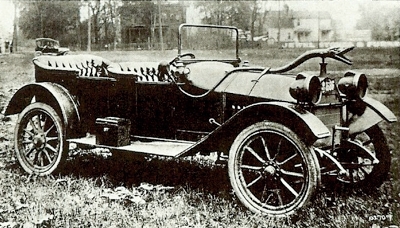 1909/1910 Hupmobile four-cylinder tourer. Note the elaborate horn.
1909/1910 Hupmobile four-cylinder tourer. Note the elaborate horn.
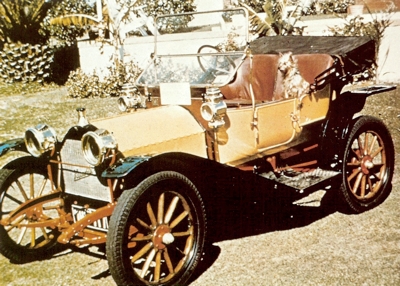 1911 Hupmobile Tourer. It was designed by Bobby Hupp and Ransom Eli Olds, who had developed the curved Dash Oldsmobile. It was fitted with a 2.8 liter side valve four cylinder engine, and proved very popular, selling 12,000 annually by 1913.
1911 Hupmobile Tourer. It was designed by Bobby Hupp and Ransom Eli Olds, who had developed the curved Dash Oldsmobile. It was fitted with a 2.8 liter side valve four cylinder engine, and proved very popular, selling 12,000 annually by 1913.
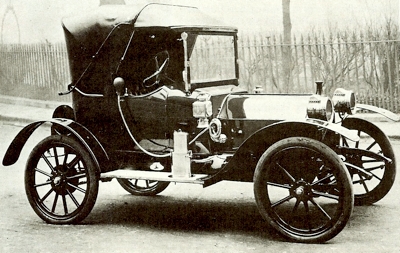 1911 Hupmobile 2 Seater.
1911 Hupmobile 2 Seater.
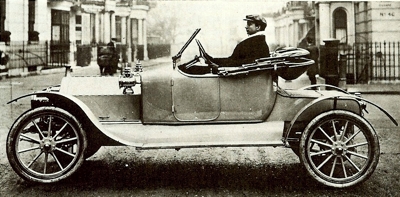 1912 Hupmobile four-seater.
1912 Hupmobile four-seater.
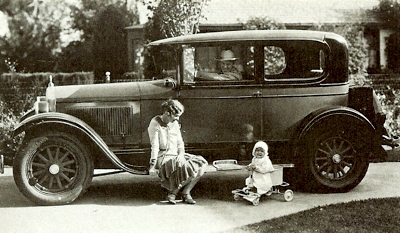 Stan Laurel of Laurel and Hardy fame, posing with his 1928 Hupmobile, wife and daughter.
Stan Laurel of Laurel and Hardy fame, posing with his 1928 Hupmobile, wife and daughter.
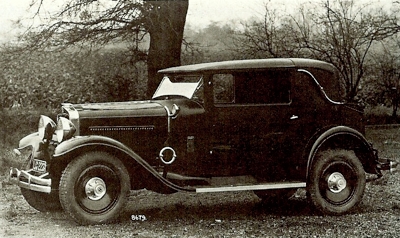 1929 Hupmobile two-door sedan.
1929 Hupmobile two-door sedan. |
By now, the company was in expansive mood and, in 1929, it took over the Chandler motor company in Cleveland, Ohio, using the Chandler factory to produce the lower-priced models. However, the Depression hit independent motor manufacturers, like Hupp, badly, and sales plummeted: from 50,374 in 1929 to 17,450 in 1931.
Although sales were down so drastically, the 1923-33 Hupmobiles were perhaps the most handsome models to be produced by the company; 1934, on the other hand, saw the announcement of the aerodynamic range, with its ultra-modern form, including special wings, severely slanting radiator, D-shaped windscreen, extended tail and prolonged headlamp fairings. This was, of course, the year of the Chrysler Airflow, so Hupmobile were well to the forefront of fashion, even though the streamlined bodywork cheapened the image of their cars.
The new aerodynamic models had been designed for lightness, and made wide use of high-tensile materials. Hydraulic dampers were fitted all round, augmented by an anti-roll bar at the rear; the front axle was tubular in section. For increased rigidity, the chassis was mounted in unit with the all-steel body-work, cross-braced and stiffened towards the front by a special truss, which extended from the scuttle forwards under the bonnet.
Big Bertha Power
In 1930, Hupmobile published the following advertisement ... "
A Hupmobile becomes a little more than just a car. He'll lift the hood as a veteran would, and show Hupp's mechanical fineness. He knows! He's driven Hupmobile since the old outdated out-of-context but still-revered early Hupmobiles with the tall steel spout on its radiator.
There's something about Hupp's faithfulness that gets to a man. A feeling that hasn't a name. But it's the same as the feeling a seaman gets for his ship, an engineer for his engine, or a woman for her home. He's got as much use for an adjective as a cowboy for a powder puff. He's rough on claims.
Promises of what a car can do. He's the old-time Hupmobile owner. He's seen cars come, seen 'em go. Only he won't talk. He'll act! Give you fact after fact, not in words but in deeds, in bullet speeds and 'Big Bertha' power."
Although some 1931 Hupmobiles had been fitted with four-speed transmissions, the new models were of the three-speed all-synchromesh type; a freewheel could be fitted. A proposed front-wheel-drive variant never reached production. The eight-cylinder model had a five-bearing crankshaft, fully counter-balanced. Equipment was comprehensive, and a radio was a standard fitting. The three-panel windscreen was cleaned by twin wipers sweeping in towards the centre to give the maximum number of blind spots.
This new model gave Hupmobile the opportunity to launch a vigorous sales and export programme: 'We have spanned the Western Ocean by establishing our depot at the free port of Antwerp with one million dollars of spares delivered before we shipped our beautiful Aerodynamic Automobile to Europe'. Here, it was claimed, the importing agents could draw on a large float of new cars to supply their customers, giving guaranteed delivery.
The agent who took over in Britain in 1935 waxed lyrical: 'Today, the would-be motorist is beset with difficulties. So many claims crowd and confuse his choice ... in sorting the wheat from the chaff it is obvious and logical that "air-moulding" must win his favour. And if he carries his logic to finality, he must buy a Hupmobile. Not only because it is streamlined-yet not self-consciously so-but because of its inspiriting performance - its comfort, speed and docile power'.
Does 28 years of Integrity Claim Your Respect?
A new 4-liter six was announced in the spring of 1935, bringing the Hupmobile range to arguably its greatest strength, with the old 3.6-liter six and the 5-liter eight (which was available in two wheelbase lengths).
At the end of the year, the company announced 'astounding price reductions', along with the catch-cry 'Does 28 years of integrity claim your respect'? The range had been trimmed, leaving only the straight-eight and the larger six; the long-wheelbase eight featured English coachwork of aerodynamic aspect, and many luxurious items of equipment, including a cocktail cabinet for the passengers.
Among the standard features of the cars were cast-aluminum wheels, which reduced unsprung weight considerably, but such devices were really aimed at reviving flagging sales, in which important respect they were a complete failure, for in mid 1936, Hupmobile suspended production for several months.
Hupmobile Automatic Overdrive
There was a revival, during which the eights gained automatic overdrive, and then Hupmobile produced one last effort. In common with Graham, they utilised the body dies of the recently defunct Cord 810/812 sedan, with the coffin-nose modified to give the effect of a more conventional. grille, and rear-wheel drive using standard Hupp mechanicals.
However, this venture proved totally abortive, and Hupmobile abandoned car production altogether. This, however, was not the end of the story. Unlike many other American car manufacturers who had suffered in the Depression, Hupmobile had learned the necessity of having several strings to their bow. Exit the Hupp Corporation, manufacturers of motor cars. Enter the Hupp Corporation, makers of car spares, kitchen equipment and electronics.
